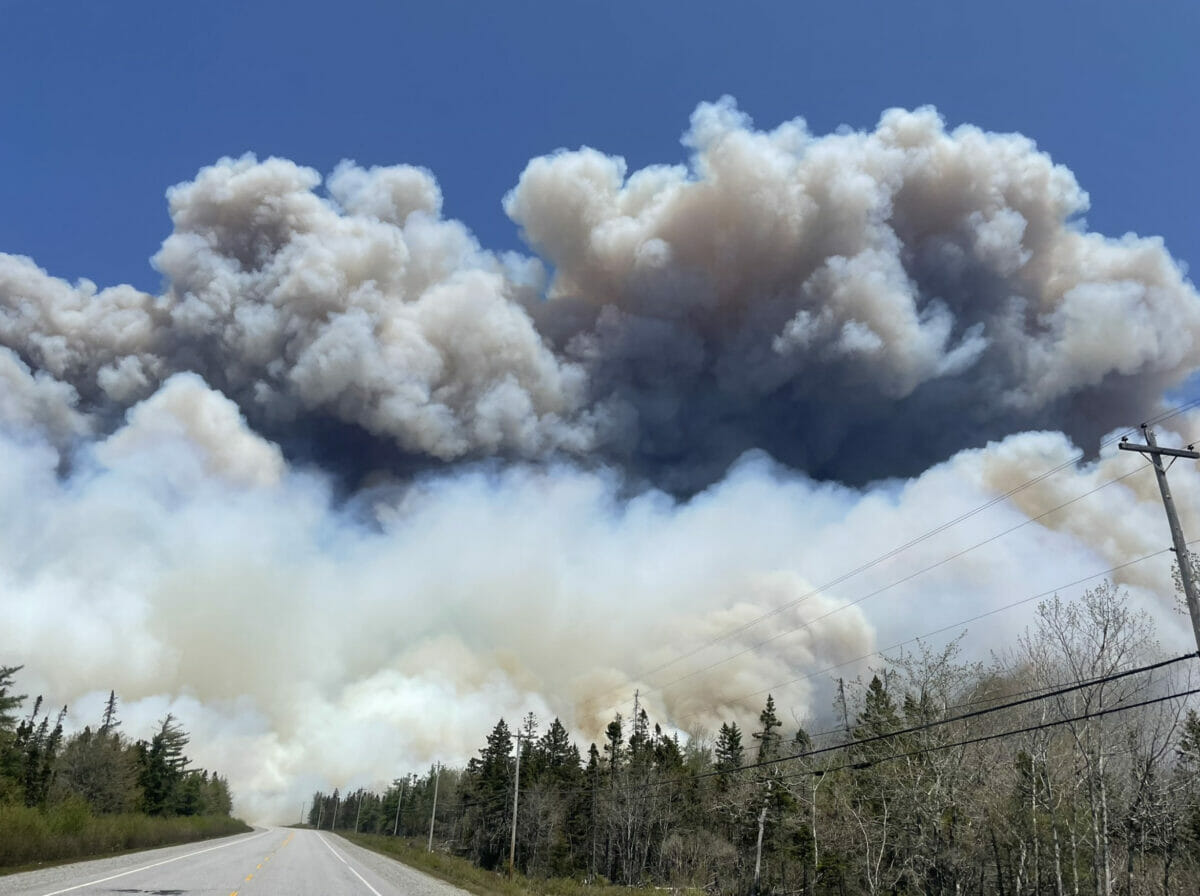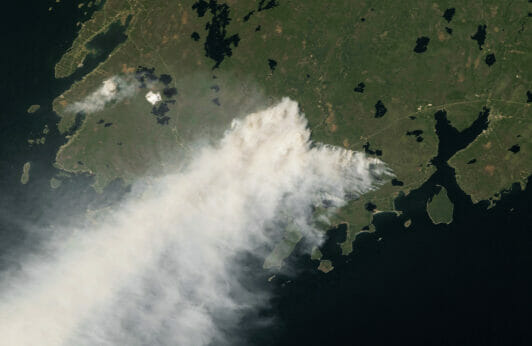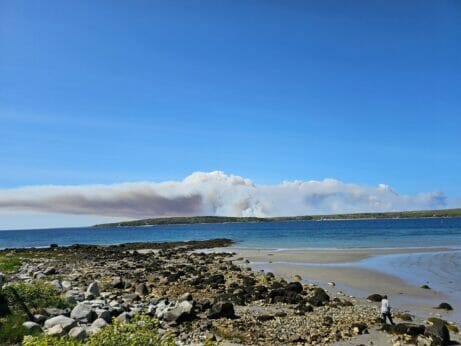Falling ash, heavy smoke and black fields: Experts worry that worsening climate conditions will make these destructive wildfires the new normal.

When the wildfires descended on his Nova Scotia farm the morning of May 28, Peter Sutherland wasn’t surprised. Drought conditions had turned the land and foliage in Shelburne County—normally lush in late May—to kindling. The fires were all that the locals were talking about for days, and the ashy smoke that billowed across the skies was soon followed by flames visible from Sutherland’s Wild Blueberry U-Pick in Clyde River, along the province’s southwestern tip, two and a half hours from the capital of Halifax. Yet he was still caught off guard when the message came: Evacuate immediately.
“I couldn’t move,” says Sutherland. “If I would have been given 15 minutes,” he trails off.
Sutherland considers himself lucky that he didn’t lose his home, but the fire destroyed a $200,000 harvester, as well as utility tractors, sprayers, a transport trailer and more. All told, Sutherland figures the damage to his equipment to be more than $400,000, and it’s not clear how much the smoke and flames have otherwise damaged his 70 acres. The fires wiped out crops on as much as 20 percent of his 35 active acres, and the pollinating bumblebees from his 40 hives have been ominously absent—a problem that he worries could affect his yields next season.
“All the lands around, just devastated,” says Sutherland. “It’s just black as you can see.”
Sutherland was one of a reported 20 or so farmers and producers affected by the fires in Nova Scotia’s Shelburne County and Halifax Regional Municipality. But countless others across Canada have felt a similar distress in recent weeks. And as farmers can attest, the impacts of a single season can last much longer and spread much wider than one wildfire.

Smoke in Nova Scotia as seen from the International Space Station. Photography courtesy of NASA.
The new normal
According to Alberta’s Ministry of Forestry and Parks, at least 640 wildfires had burned more than 1.4 billion hectares of land in the province through mid-June—already well over its five-year average of 500 fires and previous record of 1.35 million hectares (dating back to 1961). Projections for this year’s wildfire season in Canada have been described by officials as “unprecedented,” with an area nearly the size of New Mexico already having been scorched. As of press time, more than 200 wildfires ranging from British Columbia to Newfoundland and Labrador were still categorized by the Canadian Interagency Forest Fire Centre (CIFFC) as “out of control.”
Climate change experts believe this elevated wildfire threat could represent a new normal. More extreme weather patterns make for harsher drought conditions, even in places such as Canada’s eastern seaboard, which is far less accustomed to wildfire fallout than other areas of the country. When thirsty land is ignited (whether by human hands, high heat or lightning strikes), there is a number of clear and direct threats: compromised air quality, property damage and even death. Earlier this month, nearly 200 homes were damaged or destroyed in wildfires near the Halifax area. In Quebec alone, around 14,000 residents have been evacuated. And in New York and as far away as Iowa, U.S. citizens were being warned of the dangers of the fire’s smoke. But for farmers and producers, those concerns only scratch the surface.
Community efforts
Power outages caused Matthew Roy, owner of Coastal Grove Farm in Upper Port La Tour—located a few miles south of Sutherland’s Wild Blueberry U-Pick in southern Nova Scotia—to scramble for a generator and makeshift water tank in order to maintain delicate conditions in his organic operation’s geothermal greenhouse. Roy and other workers were still hand-watering when the ash began falling around them and the evacuation call came. Displaced from his farm for 11 days, Roy returned to find no fire damage, but the lack of precise moisture and ventilation cost him an estimated $3,500 in tea seedlings.
And the downstream effects are almost incalculable. Some of Roy’s crops that weren’t lost went unsold because of highway closings that cut off routes to buyers. The local farmer’s market was briefly suspended to allow folks in the area to settle back in—another hit to sales. Bringing soil moisture levels back to normal also meant inviting a weed uprising, which Roy would normally tamp down with propane torches. But, hey: wildfires. “These tangential costs are going to creep in here for the way we maintain our systems,” says Roy.
Some of that burden is picked up by the province—Nova Scotia delivered $2,500 emergency grants to its wildfire-affected farmers—and some by insurance carriers. Yet much of the heavy lifting in the moment falls to local systems, community organizations and friendly neighbors.
Roy, who is president of the Yarmouth Shelburne branch of the NSFA, helped ensure farmers and producers in his area received as much support as could be mustered. Working with the greater NSFA and the Nova Scotia Department of Agriculture, Roy and his local NSFA chapter oversaw the opening of several nearby exhibition grounds, where livestock could be transported and cared for. Shifting fire patterns forced some animals to be moved more than once. The logistics just for livestock relocation require a network that would be difficult to co-ordinate in the best of times, let alone with 1,500F° wildfires closing in.
“The rapid-response people need to have trailers available to get in and out of a farm that has 50 sheep that need to be moved or 30 cows to be picked up or 50 horses at a big boarding stable,” says Roy. “It’s coming to awareness—that component has to be there, too, because, right now, that is all done at the local level.”

Smoke over the water in Shelbourne, Nova Scotia. Photography by Patrick Hatt/Shutterstock
A Co-ordinated Approach
Moving forward, wildfire emergency responses will require not only well-co-ordinated interagency efforts but, according to Jonathan Eaton, a PhD candidate in anthropology at the University of British Columbia who studies disaster resilience, a multi-hazard approach.
“In the past, and sometimes to a certain extent today, we take each emergency as it comes, each event, and we deal with that,” says Eaton. “But I think, increasingly, there’s an understanding that a single wildfire event doesn’t start when the fire burns and it doesn’t end when the fire goes out. It’s connected to a lot of other hazards.”
As an example, Eaton describes a scenario in which intense wildfire burn in hilly or mountainous areas creates hydrophobic soil conditions, leading to runoff (which may directly affect crop health and yields) and landslide risks (which could threaten thoroughfares and vital travel access). Moreover, this multi-hazard approach dictates that response teams make important choices about “good” and “bad” wildfires. Some burning, after all, is a natural part of a grassland and forest ecosystems, and Eaton points out that wildfire-fighting resources are finite. “As we’ve seen, we haven’t been able to [suppress them all] because, inevitably, the fires get worse and worse as we try to keep all of it from happening.”
The implicit message from experts and government officials to farmers and producers: Prepare for the worst. Because of the number, scale and complexity of factors that fuel wildfires, learning to live with these events is a far more likely outcome than reducing or even mitigating them. The government of British Columbia, for instance, recommends N95 masks for workers exposed to wildfire smoke, and it provides a series of related emergency guides with information about animal health, evacuation orders and climate change adaptation.
Even for Canada’s farmers and producers who escape physical or significant financial turmoil, there is an emotional strain caused by the wildfires that shouldn’t be ignored. Sutherland was displaced from his farm for 14 days—two weeks of wondering and worrying about what was lost and what may be recovered. “You begin to hear a lot of hearsay and gossip,” he says. “It’s just gut wrenching, you know?”